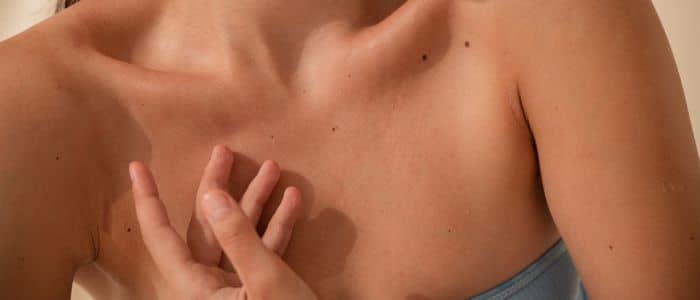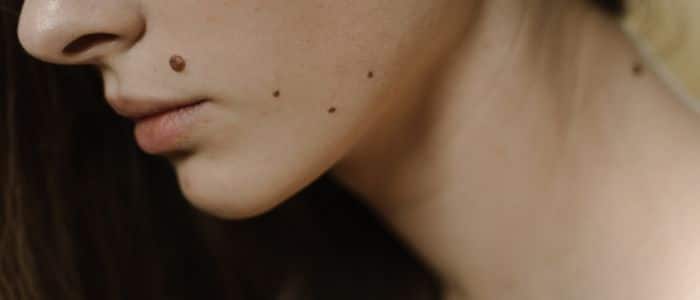
Table of Contents
- What Does a Cancerous Mole Look Like?
- What Is a Mole?
- Types of Moles
- Types of Moles Based on Appearance
- Location and Sun Exposure
- Lifespan of a Mole
- Identifying a Cancerous Mole
- The ABCDE Method
- Other Warning Signs
- Protection and Prevention
- The importance of sunscreen and its correct application
- Wearing protective clothing, hats, and sunglasses
- Avoiding peak sun hours and seeking shade
- Regular Check-ups
- Treatment Options for Cancerous Moles
- Surgical Removal Procedures
- Alternative Treatment Methods
- FAQs about Moles and Treatment Options
- Further Reading about Skin Conditions
What Does a Cancerous Mole Look Like?
Moles, those familiar pigmented spots or patches we often see on our skin, are a natural part of our body’s landscape. Almost everyone has them, with some people having as few as 10, while others might have 40 or more. These skin growths can pop up anywhere on our body, from the top of our head to the soles of our feet. They come in a variety of sizes, shapes, and shades, ranging from light tan to dark brown, making each mole as unique as the individual who has it.
While the majority of moles are benign and pose no threat, there are instances where they can be a cause for concern. The transformation from a harmless mole to a cancerous one is a reality that underscores the importance of being vigilant and observant. Recognising the early signs of a potentially cancerous mole is paramount, not just for peace of mind but for timely intervention and treatment. In this guide, we’ll explore the nuances of moles, their types, and the critical indicators that might signal a need for medical attention.
Anca Breahna is a renowned Consultant Plastic Surgeon based in Chester, known for her expertise in a wide range of plastic surgery procedures. With her extensive knowledge and experience, Anca offers mole removal surgery, ensuring patients receive the highest standard of care. Whether it’s for cosmetic reasons or concerns about changes in a mole’s appearance, patients can trust in Anca Breahna’s proficiency to provide effective and safe treatments.
What Is a Mole?
Moles, or as they are scientifically termed, nevi, are common features on the skin of many individuals. They are often viewed as simple beauty marks or blemishes, but there’s more to them than meets the eye.
Moles are formed by melanocytes, which are the skin cells responsible for producing melanin, the pigment that gives colour to our skin, hair, and eyes. When these melanocytes don’t spread out evenly across the skin but cluster together, they form moles. The colour of a mole can range from pink to brown or black, depending on factors like skin type, sun exposure, and genetics.
Types of Moles
- Congenital moles: These are moles that are present at birth. They can vary in size and are usually benign, but it’s always a good idea to have them checked by a doctor
- Acquired moles: These moles appear during childhood or adulthood. They’re usually caused by sun exposure and are less than a quarter-inch in diameter. Most acquired moles are benign
- Atypical moles: Also known as dysplastic nevi, these moles can look like melanoma. They’re often larger than a pencil eraser and can be a mix of colours. It’s essential to monitor these moles and seek medical advice if they change in appearance
Types of Moles Based on Appearance
- Flat moles: These moles are usually level with the skin and might be difficult to feel when you run your fingers over them
- Raised moles: These are elevated above the skin’s surface and can be easily felt
- Hairy moles: Some moles have hair growing from them, which is a natural occurrence and not a cause for concern
Location and Sun Exposure
Moles can appear on any part of the body, from the face and arms to the legs and even under the nails. While sun exposure can influence the appearance of some moles, they can also form on parts of the body that are rarely or never exposed to the sun, such as the soles of the feet or the palms of the hands. It’s a misconception that only sun-exposed areas can develop moles; they truly can appear anywhere.
Lifespan of a Mole
Moles can change over time, and this evolution is a natural part of their lifespan. They might darken, lighten, grow, or even disappear as you age. Changes in hormones, especially during teenage years, pregnancy, or ageing, can influence the appearance and number of moles.
Identifying a Cancerous Mole

Skin health is vital, and while moles are often harmless, it’s essential to be aware of the signs that might indicate something more serious. Early detection is key when it comes to skin cancer, and understanding how to identify a potentially cancerous mole can make all the difference.
The ABCDE Method
This method provides an easy-to-remember guideline for assessing moles:
- Asymmetry: A benign mole is often symmetrical. If you were to draw a line down the middle of your mole and the two halves don’t match, this could be a sign of asymmetry, which might indicate a problem
- Border: Healthy moles tend to have clear, defined borders. If the edges of the mole are irregular, blurred, or jagged, it’s time to take note
- Colour: Uniformity in colour is typical for non-cancerous moles. Multiple shades of brown, tan, black, or even blue, red, or white within a single mole should be a cause for attention
- Diameter: Generally, smaller moles are less of a concern. However, if a mole is larger than the size of a pencil’s eraser, it’s worth getting it checked
- Evolving: Moles that change over time, be it in size, shape, or colour, should be monitored. Any noticeable evolution in a mole’s appearance is worth discussing with a healthcare professional
Other Warning Signs
While the ABCDE method is a valuable tool, there are other symptoms and signs to be aware of:
- Itching or pain: Occasional itching might not be a concern, but if a mole consistently itches or causes pain, it’s worth seeking advice
- Bleeding or oozing: A mole that bleeds, exudes fluid, or becomes crusty should be examined by a professional
- Rapid changes in appearance: A mole that grows quickly or undergoes rapid changes in its characteristics is a sign that you should consult with a dermatologist
Protection and Prevention
Regular skin checks, both at home and with a specialist, can help in early detection. Additionally, protecting your skin from excessive sun exposure by wearing sunscreen, hats, and protective clothing can reduce the risk of skin cancer.
By taking simple protective measures, you can reduce the risk of developing new moles and ensure the ones you have remain benign.
The importance of sunscreen and its correct application
- Sunscreen acts as a shield against the harmful UV rays from the sun
- Always opt for a broad-spectrum sunscreen that protects against both UVA and UVB rays
- Aim for a minimum SPF of 30 and remember to reapply every two hours, especially after swimming or sweating
- Don’t forget areas like the back of your neck, ears, and tops of your feet
Wearing protective clothing, hats, and sunglasses
- Clothes can act as a barrier against sun exposure; opt for long-sleeved shirts and long trousers when possible
- Wide-brimmed hats provide shade for your face, neck, and ears
- Sunglasses with UV protection shield your eyes and the sensitive skin around them
Avoiding peak sun hours and seeking shade
- The sun is strongest between 10 am and 4 pm; try to stay indoors or in shaded areas during these times
- If you’re outside, use umbrellas or sit under trees to minimise direct sun exposure
Regular Check-ups
- Monitoring your skin is a proactive way to ensure its health. Regular check-ups can make all the difference in early detection and treatment
Treatment Options for Cancerous Moles
Navigating the world of skin health can sometimes be overwhelming, especially when faced with concerns about potentially cancerous moles. However, with advancements in medical technology and procedures, there are several effective treatment options available. The chosen method often hinges on various factors, including the mole’s size, its location, and its type.
Surgical Removal Procedures
When it comes to removing moles, surgical procedures are often the first line of treatment. These methods are designed to remove the mole entirely, ensuring that no potentially harmful cells remain.
- Excision: This is a standard procedure for mole removal, especially for larger moles or those that appear suspicious. The process involves numbing the area, making an incision, and removing the mole along with a small margin of healthy skin to ensure all potentially harmful cells are taken out. Once the mole is removed, the wound is closed using stitches, which might be left in place for up to two weeks, depending on the size and location of the excision
- Shave Excision: Suitable for smaller moles that are raised above the skin’s surface. The area is numbed, and the mole is carefully “shaved” off, ensuring minimal damage to the surrounding skin. This method often doesn’t require stitches and leaves minimal scarring
Alternative Treatment Methods
For those who might be hesitant about surgical procedures or for moles that are challenging to treat surgically, there are alternative treatments available.
- Cryotherapy: A non-invasive procedure where the mole is frozen using liquid nitrogen. The extreme cold causes the mole to form a blister and eventually fall off. It’s a quick procedure, but there might be some discomfort as the skin thaws post-treatment
- Laser Therapy: Uses focused beams of light to target and break down the mole. It’s especially useful for moles that are flat and don’t protrude above the skin’s surface. Multiple sessions might be required to achieve the desired result
- Radiation: This method is less common and is usually reserved for situations where there’s a concern that not all cancerous cells were removed during surgery. It involves targeting the affected area with controlled doses of radiation to kill any remaining harmful cells
FAQs about Moles and Treatment Options

What is the difference between a benign mole and a potentially cancerous one?
A benign mole is non-cancerous and usually has a uniform colour, smooth borders, and remains consistent in appearance over time. A potentially cancerous mole might change in size, shape, or colour, have irregular borders, or exhibit other warning signs like itching or bleeding.
How can I determine if my mole needs to be checked by a professional?
If your mole shows signs of asymmetry, has irregular borders, changes in colour, is larger than a pencil eraser, or evolves in any way, it’s advisable to have it checked by a professional. Any sudden itching, bleeding, or pain should also be a reason for consultation.
What does the mole removal procedure involve?
The procedure typically involves numbing the area around the mole and then excising or shaving off the mole. The method chosen often depends on the size, location, and type of mole. After removal, stitches might be used, or a dressing applied.
Are there any risks associated with mole removal?
As with any surgical procedure, there are potential risks, including infection, scarring, or an allergic reaction to the local anaesthetic. However, when performed by a qualified professional, complications are rare.
How long is the recovery period after mole removal?
Recovery largely depends on the method of removal. Generally, the area might be red or swollen for a few days. If stitches are used, they might need to be removed after a week or two. It’s essential to follow post-care instructions and avoid direct sun exposure to the treated area.
Medical References about Moles
- Patient Understanding of Moles and Skin Cancer – NCBI
- Moles – Cleveland Clinic
- Should I Worry About a Mole? – Medical News Today
- Moles – Symptoms and Causes – Mayo Clinic
- Common Moles, Dysplastic Nevi, and Risk of Melanoma – National Cancer Institute
Further Reading about Skin Conditions
- Read more about Scars
- Read more about Skin Cancer
- Read more about Lumps, Bumps & Lesions
- Read more about Lines & Wrinkles






